Table of Contents
- Introduction
- Editor’s Choice
- Global Healthcare Staffing Scenario Statistics
- Relationship between Healthcare Staffing and Patient Mortality Statistics
- Motivation and Retention of Healthcare Staffing in Developing Country Statistics
- Reasons for Healthcare Staffing Considering Leaving the Workforce Statistics
- Healthcare Staffing Workforce Demographics in the U.S Statistics
- Regional Analysis Healthcare Staffing Statistics
- Recent Developments
- Conclusion
- FAQs
Introduction
Healthcare Staffing Statistics: Healthcare staffing is a crucial facet of the healthcare industry. Involves the recruitment, hiring, and management of qualified professionals to meet the ever-changing demands of patients and medical institutions.
This intricate process plays a pivotal role in ensuring high-quality patient care by matching individuals’ skills and qualifications to specific roles, considering factors like patient load and location.
Effective healthcare staffing requires anticipating staffing needs, managing schedules, addressing turnover, and adhering to regulatory standards.
Inadequate staffing can jeopardize patient safety and care quality. Effective staffing enhances patient outcomes and experiences, making it a cornerstone of healthcare delivery.
In essence, healthcare staffing is a complex, indispensable process that directly impacts patient well-being and the overall success of healthcare organizations. Demanding meticulous planning and unwavering commitment to excellent patient care.
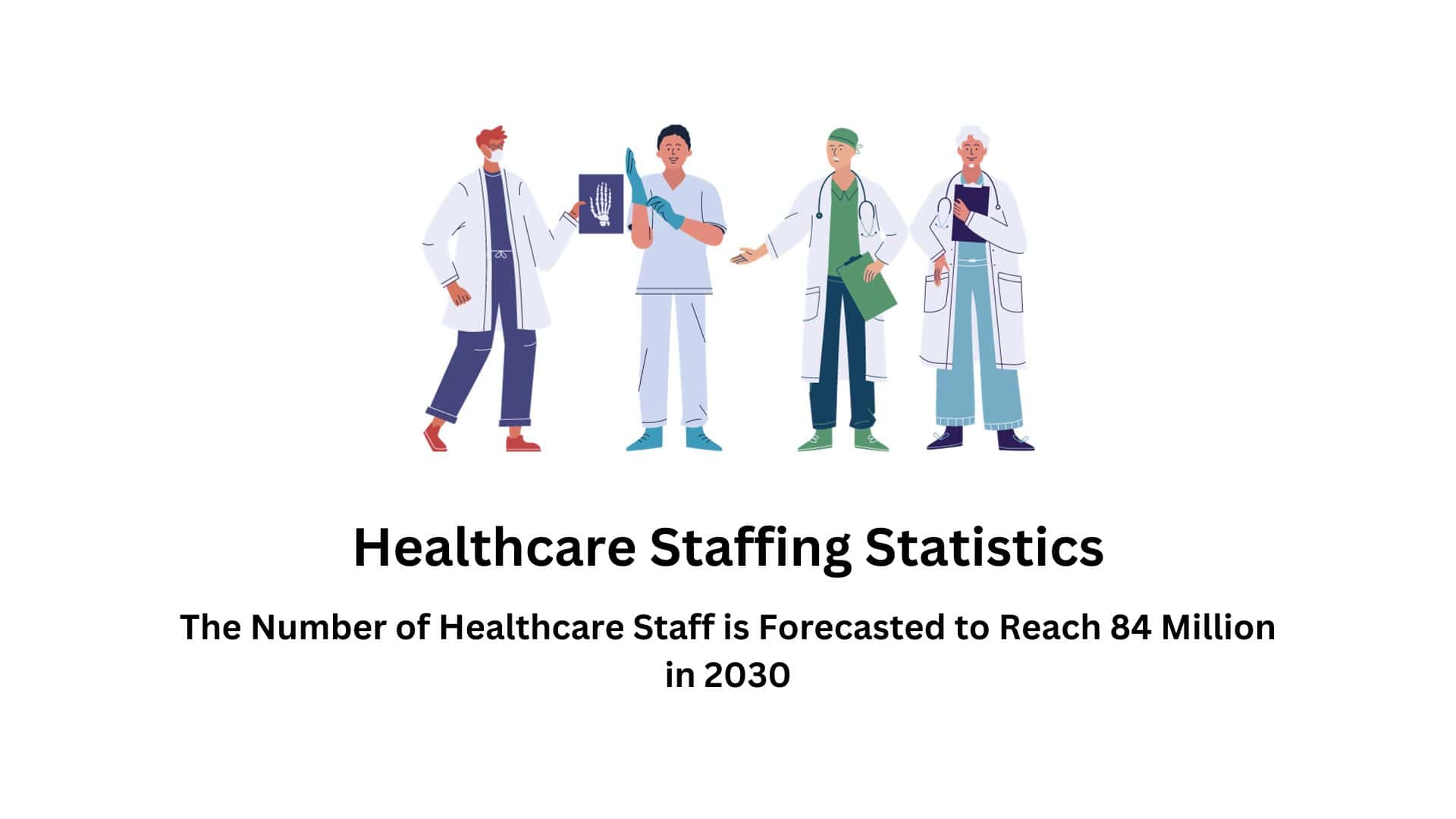
Editor’s Choice
- Per Diem Nurse Staffing Market is projected to be USD 8,535.69 Mn in 2021 to reach USD 15,071.18 Mn by 2031 at a CAGR of 5.85%.
- A total of 65.1 million health workers were recorded as contributing to the healthcare industry in 2020.
- It is estimated to reach about 84 million workers by 2030 growing at 29% from 2020-2030.
- There will be a 34% reduction in healthcare workforce shortage from 15.4 million to 10.2 million from 2020 to 2030.
- The job rate in healthcare staff is expected to be 2.7% to create approximately 19 million jobs by the year 2030.
- 90% of healthcare staff take up the job for financial incentives.
- 1 Registered nurse increase leads to a 1% decrease in patient mortality.
- Pay is considered as the number one reason for leaving the job and Lack of opportunities for advancement comes at second place with 59% and 51% staff respectively.
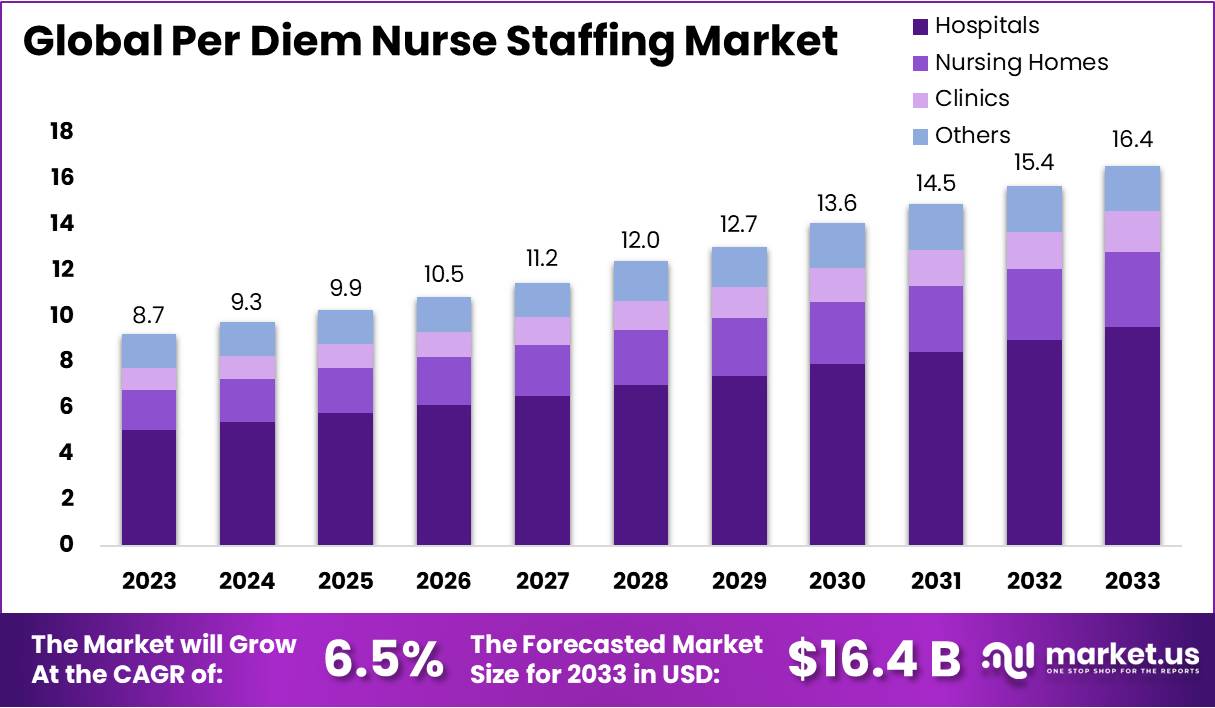
Global Healthcare Staffing Scenario Statistics
Global Healthforce
- In 2020, there were 29.1 million nurses, 12.7 million medical doctors, 3.7 million pharmacists, 2.5 million dentists, and 2.2 million midwives. And 14.9 million individuals in various other healthcare roles worldwide, totaling 65.1 million health workers.
- By 2030, it is estimated that the global health workforce will increase to 84 million health workers. This growth signifies an average rise of 29% from 2020 to 2030. A rate significantly higher than the population growth rate of 9.7%.
(Source: BMJ Journals)
Healthforce Shortage
- In 2020, there was a global shortage of 15.4 million health workers, a figure expected to decrease to around 10.2 million by 2030, marking a 34% reduction.
- In 2013, the shortage of medical workforce consisted of 0.49 million dentists, 3.05 million medical doctors, 0.36 million midwifery personnel, 9.89 million nursing personnel, 0.33 million pharmacists, and 6.02 million in other healthcare roles.
- There was an improvement in the shortage in 2020, with about 0.26 million dentists, 2.66 million medical doctors, 0.41 million midwifery personnel, 7.07 million nursing personnel, 0.29 million pharmacists, and 4.69 million in other healthcare roles.
- The projections for 2030 indicate further improvements in the deficits. With 0.22 million dentists, 1.94 million medical doctors, 0.31 million midwifery personnel, 4.5 million nursing personnel, 0.19 million pharmacists, and 3.08 million in other healthcare roles.
- The situation in the WHO African region remains uncertain. With shortages estimated at 5.1 million, 5.7 million, and 5.3 million in 2013, 2020, and 2030, respectively.
- Due to rapid population growth, health worker shortages in the WHO African region are expected to make up 52% of the global shortage by 2030, compared to a quarter in 2013.
(Source: BMJ Journals)
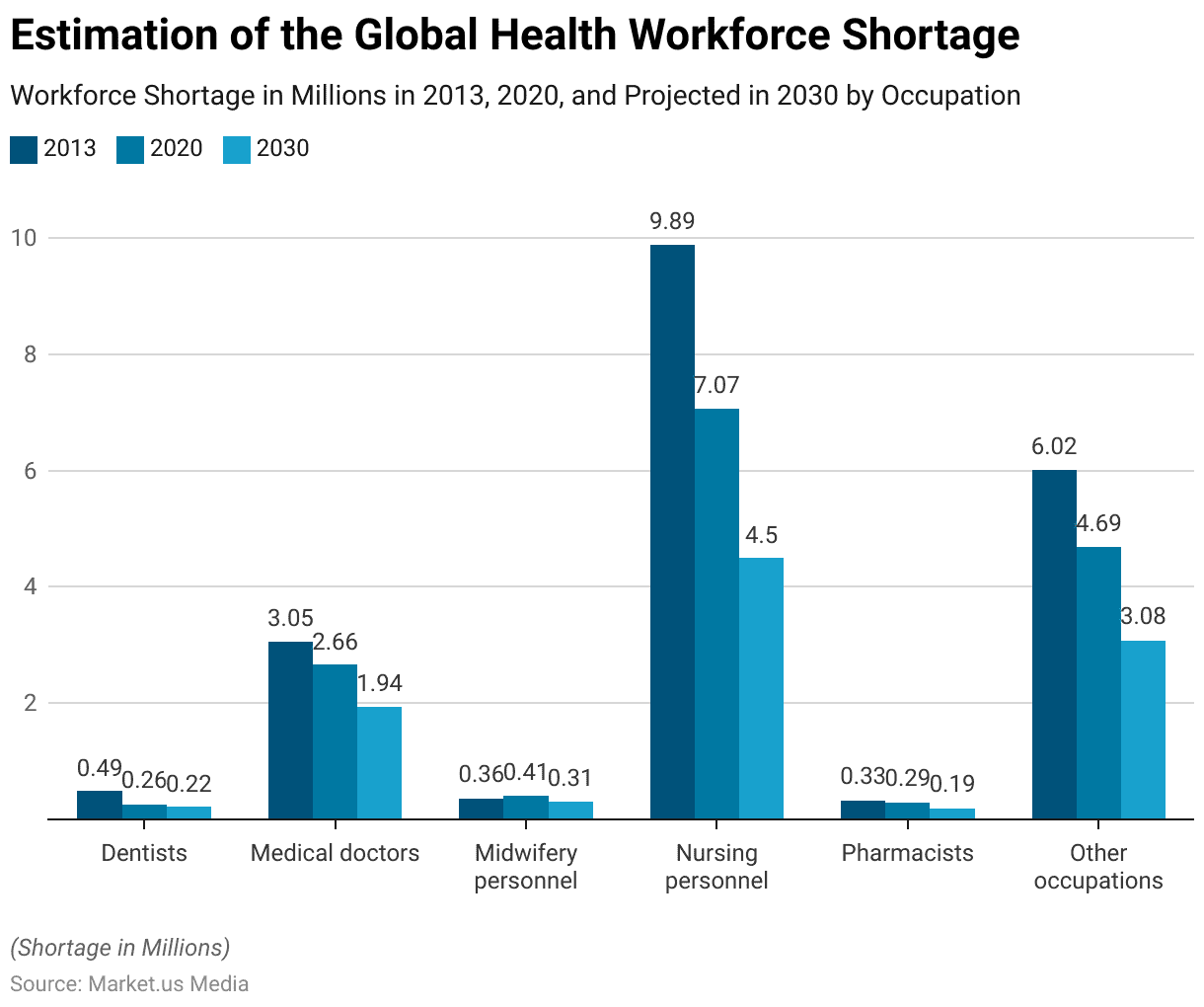
Comparison of The Total No. Of Jobs
- The latest data from the NHWA for 2020 reveals a significant increase in the global health workforce in 2020. With 14 million additional jobs, marking a 27% rise compared to 2013 figures.
- By 2030, the projection of a 2.7% annual growth rate in the health workforce, compared to a 0.9% global population growth rate. This could lead to the creation of 19 million additional health worker jobs by 2030.
(Source: BMJ Journals)
Relationship between Healthcare Staffing and Patient Mortality Statistics
- In a series of studies investigating the impact of healthcare staffing on patient mortality, notable correlations have been found.
- Specifically, higher levels of registered nurse staffing were linked to lower mortality rates in 7 out of 12 studies.
- For instance, an increase of 1 RN hour per patient day was associated with a reduction in the odds of death by less than 1%, and an additional nurse per bed lowered the absolute death rate by 0.26%.
- In ICU settings, an additional RN per bed reduced death odds by 8%.
- Conversely, the data on nursing assistant staffing levels showed mixed results; one study found a beneficial effect, while two others reported a 0.4% absolute risk increase in mortality for each additional assistant per bed.
- In terms of physician staffing, 7 out of 11 studies indicated that higher physician levels corresponded with lower hospital mortality rates.
- Remarkably, one study noted that the risk of mortality doubled when there were more than 14 patients per physician, compared to fewer than 8.
- This comprehensive data highlights the intricate relationship between healthcare staffing levels and patient outcomes, emphasizing the importance of optimal staffing in hospitals to enhance patient care and reduce mortality rates.
(Source: National List of Medicines)
Motivation and Retention of Healthcare Staffing in Developing Country Statistics
- These papers employed various research methodologies: eight of them utilized qualitative methods, another eight adopted quantitative methods, and the remaining four papers combined both qualitative and quantitative approaches.
- Nearly 90% of the studies emphasized the significance of financial incentives, but it was underscored that these should be complemented by other motivators.
- Approximately 85% of the research noted the importance of career development opportunities, particularly in rural areas.
- The data revealed that 80% of the studies highlighted the role of effective hospital management as a motivator.
- Education and training opportunities had a strong impact, as indicated by their mention in around 75% of the studies.
- Approximately 70% of the research discussed the importance of recognition and appreciation, whether from managers, colleagues, or the community, in motivating health workers.
- The availability of hospital resources and infrastructure was a common theme in roughly 75% of the studies. Addressing these factors comprehensively is essential for retaining and motivating healthcare professionals and enhancing patient care.
(Source: National List of Medicines)
Reasons for Healthcare Staffing Considering Leaving the Workforce Statistics
- For individuals younger than 33 years, the percentage citing “Pay” as the reason for leaving a job is 66%, ranking it first. For those aged 33 years or older, the percentage is 56%, also ranking it first. The overall percentage for Pay is 59%.
- “Lack of opportunities for advancement” is cited by 53% of individuals younger than 33 years, ranking it second. Among those aged 33 years or older, 51% mention it as well, ranking it second. The overall percentage for this reason is 51%.
- “Job satisfaction” is mentioned by 37% of individuals younger than 33 years, ranking it third. For those aged 33 years or older, it ranks 5th, with 30% mentioning it. The overall percentage for “Job satisfaction” is 32%.
- “Workplace environment” is cited by 36% of individuals younger than 33 years, ranking it fourth. Among those aged 33 years or older, 39% mention it, ranking it third. The overall percentage for this reason is 38%.
- “Other opportunities outside the agency” is mentioned by 31% of individuals younger than 33 years, ranking it fifth. For those aged 33 years or older, 20% mention it, ranking it eleventh. The overall percentage for this reason is 22%.
More Reasons for Considering Healthcare Staffing Statistics
- “Lack of acknowledgment/recognition” is cited by 28% of individuals younger than 33 years, ranking it sixth. Among those aged 33 years or older, it also ranks sixth, with 30% mentioning it. The overall percentage for this reason is 29%.
- “Lack of support” is mentioned by 26% of individuals younger than 33 years, ranking it seventh. For those aged 33 years or older, 32% mention it, ranking it fourth. The overall percentage for this reason is 31%.
- “Work overload/burnout” is cited by 26% of individuals younger than 33 years, ranking it eighth. Among those aged 33 years or older, 28% mention it, ranking it seventh. The overall percentage for this reason is 28%.
- “Stress” is mentioned by 25% of individuals younger than 33 years, ranking it ninth. For those aged 33 years or older, it ranks eighth, with 27% mentioning it. The overall percentage for this reason is 27%.
- The category “Other” has a percentage of 24% for individuals younger than 33 years, ranking it tenth. For those aged 33 years or older, it ranks tenth as well, with a percentage of 23%. The overall percentage for this category is 23%.
(Source: American Journal of Preventive Medicine)
Healthcare Staffing Workforce Demographics in the U.S Statistics
- The age distribution is segmented into three brackets: under 33, 33 to 54, and over 55 years, but specific percentages for these groups aren’t detailed.
- Regarding supervisory roles, the bulk of the employees are nonsupervisory, with percentages at 88%, 69%, and 69% across different national totals.
- Supervisors account for 9%, 18%, and 18%, whereas managers and executives are at 2%, 10% and 10%, and 1%, 2%, and 3% respectively across the different age groups.
- The gender composition is predominantly female, with 81%, 79%, and 77% in respective categories, and males comprise 18%, 21% and 23%.
- A nominal segment, 1%, 1%, and 0% is identified as no binary or other.
- In terms of racial and ethnic diversity, the workforce includes American Indians (0% across all categories), Asians (5%, 6%, 4%), Black/African Americans (13%, 17%, 16%), Hispanic/Latinos (18%, 14%, 8%), Native Hawaiian/Pacific Islanders (0%, 1%, 0%), and Whites (54%, 56%, 66%).
(Source: American Journal of Preventive Medicine)
Regional Analysis Healthcare Staffing Statistics
United States of America
- The data illustrates the density of different medical occupations per 10,000 populations in the United States.
- In terms of medical doctors, there are 35.55 doctors for every 10,000 people, highlighting the presence of a substantial physician workforce.
- Nursing staff, including registered nurses and other healthcare professionals, is notably higher, with a density of 124.68 per 10,000 populations, underscoring the significant role they play in healthcare delivery.
- In contrast, midwifery personnel have a lower presence at 0.33 per 10,000 populations.
- Dentists are present at a rate of 5.99 per 10,000 population, indicating accessibility to dental care.
- Pharmacists, with a density of 10.63 per 10,000 population, contribute to the accessibility of medications and pharmaceutical services. These statistics offer valuable insights into the distribution of key medical professionals, reflecting the healthcare landscape in the USA.
- 292,681 Physiotherapists are available in the US.
- Medical and Pathology Laboratory scientists available in the US accounted for.
(Source: National Health Workforce Accounts, WHO)
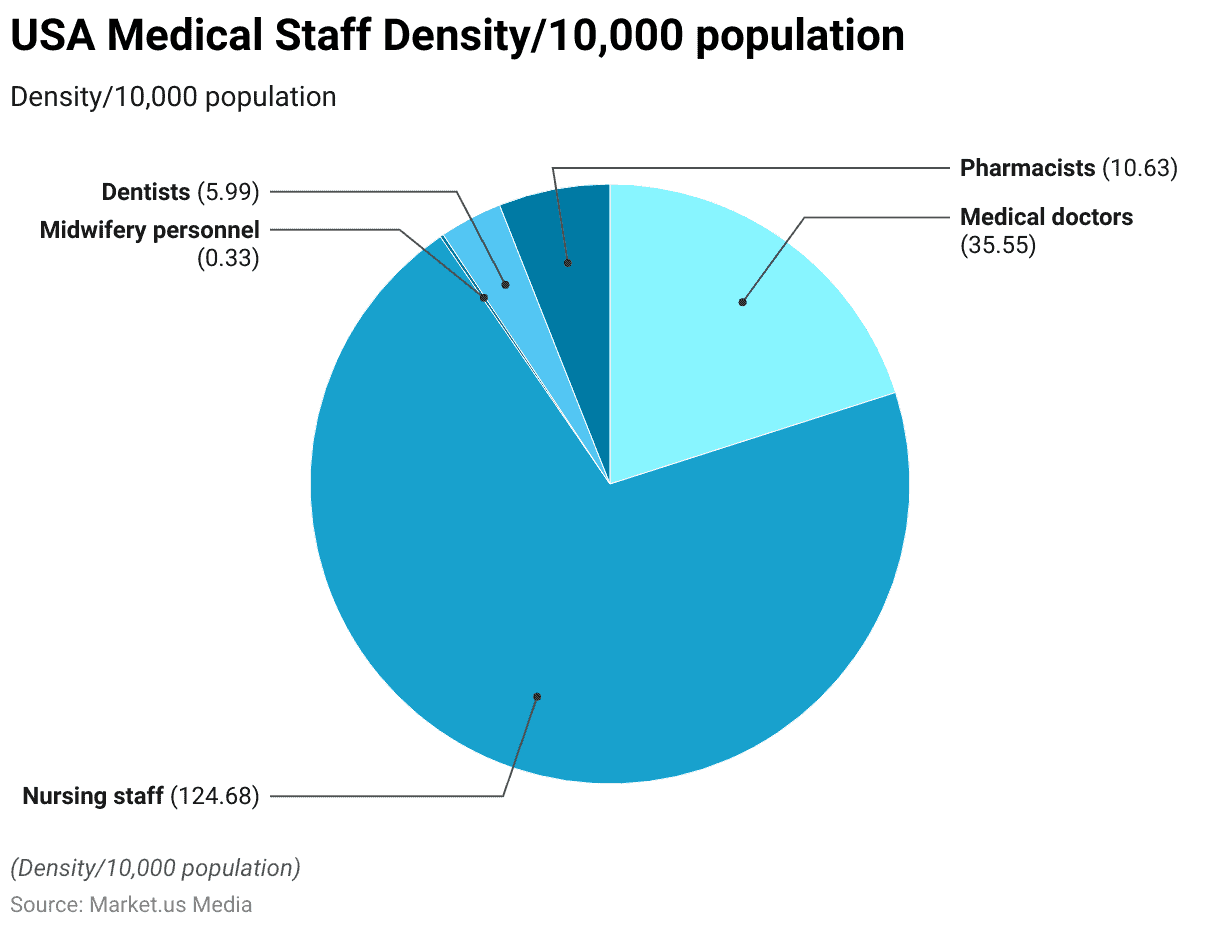
United Kingdom
- The data outlines the prevalence of various medical roles per 10,000 individuals in the United Kingdom.
- Medical doctors are present at a rate of 31.71 per 10,000 people, indicating a substantial physician workforce.
- Nursing staff, including registered nurses and other healthcare workers, are notably more abundant, with a density of 86.86 per 10,000 populations, signifying their vital role in healthcare provision.
- Midwifery personnel have a presence at 4.81 per 10,000 populations, emphasizing their contribution to maternal and neonatal care.
- Dentists are accessible at a rate of 5.15 per 10,000 population, ensuring the availability of dental healthcare services.
- Pharmacists, with a density of 8.53 per 10,000 population, facilitate access to medications and pharmaceutical services.
- 31,760 Physiotherapists recorded in the UK.
(Source: National Health Workforce Accounts, WHO)
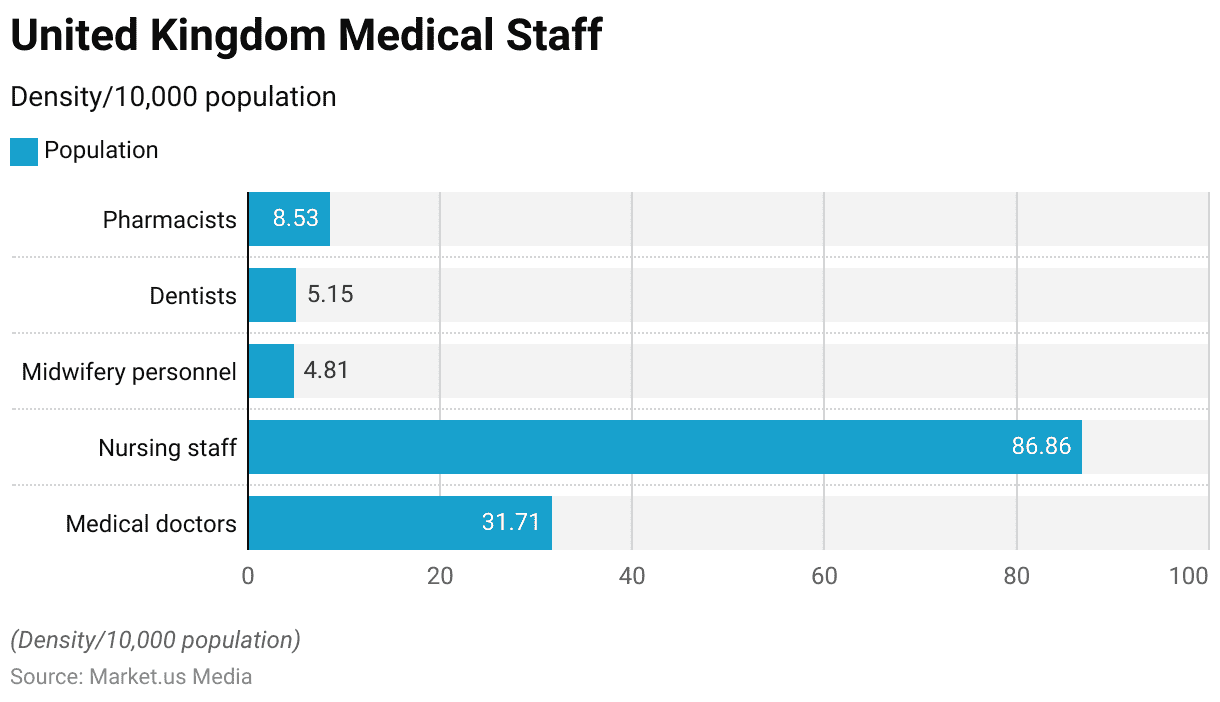
Brazil
- The data portrays the prevalence of different medical roles per 10,000 individuals in Brazil.
- There are 21.42 medical doctors for every 10,000 people, indicating a substantial physician presence in the country’s healthcare system.
- Nursing staff, including registered nurses and other healthcare workers, are notably abundant, with a density of 55.13 per 10,000 population, highlighting their critical role in healthcare provision.
- Midwifery personnel, with a density of 0.28 per 10,000 population, play a role in maternal and neonatal care.
- Dentists are available at a rate of 6.68 per 10,000 population, ensuring access to dental healthcare services.
- Pharmacists, with a density of 3.36 per 10,000 population, facilitate access to medications and pharmaceutical services.
- Brazil has around 101,718 Physiotherapists and 13,924 Medical and Pathology Laboratory scientists.
(Source: National Health Workforce Accounts, WHO)
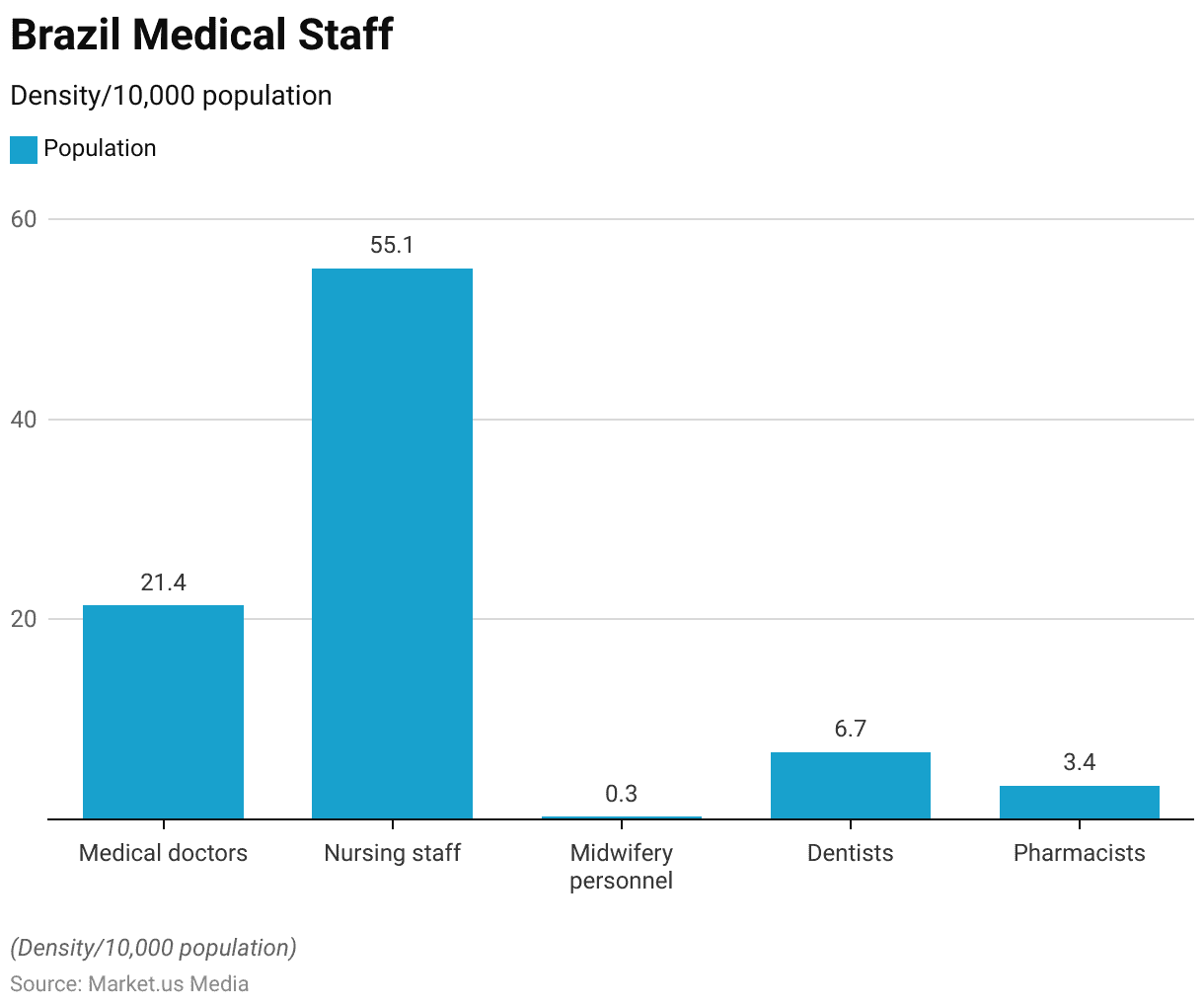
India
- There are 7.27 medical doctors for every 10,000 people, indicating the presence of physicians within the healthcare system.
- Nursing staff, encompassing registered nurses and other healthcare workers, are notably more abundant, with a density of 17.28 per 10,000 populations, highlighting their critical role in healthcare provision.
- Midwifery personnel, with a density of 6.21 per 10,000 populations, contribute significantly to maternal and neonatal care.
- Dentists are accessible at a rate of 1.6 per 10,000 population, ensuring access to dental healthcare services.
- Pharmacists, with a density of 8.6 per 10,000 population, facilitate access to medications and pharmaceutical services.
- There are about 113,937 Physiotherapists in India and 635,500 Medical and Pathology Laboratory scientists.
(Source: National Health Workforce Accounts, WHO)

Australia
- There are 41.02 medical doctors for every 10,000 people, indicating a significant presence of physicians within the healthcare system.
- Nursing staff, which includes registered nurses and other healthcare professionals, are notably abundant, with a density of 137.99 per 10,000 population, underscoring their crucial role in healthcare delivery.
- Midwifery personnel, at a density of 10.17 per 10,000 populations, contribute significantly to maternal and neonatal care.
- Dentists are accessible at a rate of 6.29 per 10,000 population, ensuring access to dental healthcare services.
- Pharmacists, with a density of 10.44 per 10,000 population, are essential in providing access to medications and pharmaceutical services.
- The no. of Physiotherapist personnel in Australia is estimated at 30,527.
(Source: National Health Workforce Accounts, WHO)

Recent Developments
Acquisitions and Mergers:
- Over the last quarter, the healthcare staffing sector has seen a notable increase in consolidation activities, with 17 mergers and acquisitions taking place globally. A significant transaction included AMN Healthcare’s acquisition of Aya Healthcare, a leading provider of travel nurse staffing, for $1.1 billion, aimed at expanding AMN’s presence in the travel nursing market.
- Additionally, Cross Country Healthcare’s merger with Health Carousel’s workforce solutions division for $167.5 million strengthened its position in the allied staffing and travel nursing segments.
New Product Launches:
- Healthcare staffing agencies introduced 32 new products and services in the previous quarter to enhance recruitment and workforce management capabilities. Noteworthy among these was the launch of Bullhorn’s Staffing Reimagined™ platform, integrating artificial intelligence and automation to streamline candidate sourcing and placement processes.
- NurseGrid’s release of NurseGrid Manager™, a workforce management solution for healthcare facilities, aimed at optimizing scheduling, reducing administrative burden, and improving staff satisfaction.
Funding and Investments:
- Venture capital investment in healthcare staffing startups totaled $320 million in the last quarter, reflecting continued investor interest in innovative workforce solutions. Notable funding rounds included a $50 million investment in Nomad Health, a digital marketplace connecting healthcare facilities with freelance clinicians, to support its expansion efforts.
- Furthermore, private equity firms injected $1.2 billion into established staffing agencies, fueling growth initiatives and strategic acquisitions to capture a larger share of the healthcare staffing market.
Technological Advancements:
- Technological advancements in healthcare staffing solutions have gained momentum, with 45% of staffing agencies adopting AI-powered tools for candidate matching and engagement. This includes platforms like Relode’s AI-driven talent marketplace, which leverages machine learning algorithms to connect healthcare facilities with qualified candidates efficiently.
- Moreover, virtual reality (VR) simulations for healthcare training have gained traction, with companies like Virti raising $10 million in funding to expand their VR-based training platform for medical professionals, addressing skill gaps and improving clinical competency.
Workforce Trends:
- The healthcare staffing industry witnessed a 12% increase in demand for temporary healthcare workers compared to the previous quarter, driven by seasonal fluctuations and COVID-19-related staffing needs. This surge in demand led to a 7% rise in hourly wages for temporary healthcare staff, highlighting the competitive nature of the staffing market.
- Additionally, remote work arrangements gained popularity among healthcare professionals, with 23% of nurses and allied health workers expressing a preference for telecommuting options. This prompted staffing agencies to offer flexible work arrangements to attract top talent.
Conclusion
Healthcare Staffing Statistics – In conclusion, healthcare staffing is the linchpin of quality patient care. It involves recruiting, hiring, and managing healthcare professionals, directly impacting service efficiency and safety.
Adequate staffing, matched with skills and qualifications, ensures patient needs are met, while effective scheduling and compliance are vital.
Inadequate staffing risks patient safety, but effective staffing enhances outcomes. It’s essential for patient well-being and organizational success, demanding commitment, planning, and excellent care delivery.
FAQs
Healthcare staffing involves the process of recruiting, hiring, and managing qualified healthcare professionals to work in medical facilities.
Adequate staffing ensures that medical facilities can provide quality care, maintain efficiency, and meet regulatory requirements.
Staffing needs are assessed based on factors like patient numbers and the specific roles required in different departments.
Staffing agencies can provide nurses, physicians, therapists, technicians, administrative staff, and support personnel.
Inadequate staffing can lead to longer patient wait times, compromised safety, reduced care quality, and overwhelmed staff.
Proper staffing is linked to improved patient outcomes, reduced errors, and better patient experiences.
Discuss your needs with our analyst
Please share your requirements with more details so our analyst can check if they can solve your problem(s)



